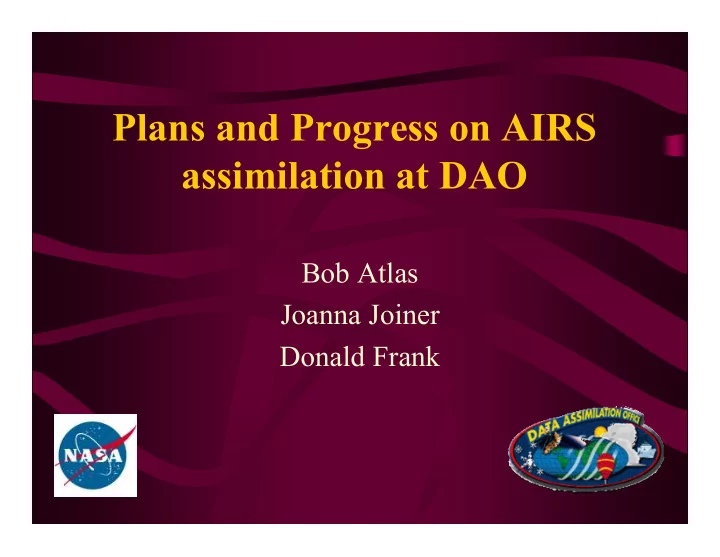

Plans and Progress on AIRS assimilation at DAO Bob Atlas Joanna Joiner Donald Frank
Progress Report since last meeting • Web-based monitoring of radiance/retrieval biases, quality control decisions, and coverage • Implemented OPTRAN – Tested with TOVS – Began testing with simulated AIRS data • Software completed to read and archive level 1b test data sets from NESDIS and compute observed minus forecast radiances • Received level2 test data sets from NESDIS, software nearly complete for assimilation • Began modifications to DAOTOVS software to incorporate AIRS – Testing with internally-synthesized radiances November, 2001 AIRS meeting, Joanna Joiner 2
Features in NESDIS 1b data sets • Some strange radiance values (noisy) are seen over e.g.Greenland • Emissivities significantly different from Masuda ocean model or CERES land emissivity data set? – Radiances in clear scenes fail cloud-detection checks, especially over ocean – Most retrievals fail radiance residual checks November, 2001 AIRS meeting, Joanna Joiner 3
OPTRAN significantly reduces ATOVS radiance biases: note: a) scale b) large reduction in channel 1 and 12 biases OPTRAN GLATOVS November, 2001 AIRS meeting, Joanna Joiner 4
Scan-angle-dependent biases (red: before tuning, green: after) GLATOVS OPTRAN November, 2001 AIRS meeting, Joanna Joiner 5
Radiances (O-F) 649.6 cm -1 (note: noisy values over Greenland, middle right shows where passed cloud- detection checks, less strict over land) November, 2001 AIRS meeting, Joanna Joiner 6
Left: Obs 801 cm -1 (window), Right: O-F 1571.9 cm -1 (H 2 O) November, 2001 AIRS meeting, Joanna Joiner 7
DAOTOVS 1DVAR system • Uses raw (level 1b) data • Variational cloud-clearing (Joiner and Rokke, 2000; http://dao.gsfc.nasa.gov/pages/jjoiner.html); eigen- vector FOV determination (AIRS ATBD) • Physically-based systematic error correction (tuning) • Forward models: OPTRAN, as well as GLATOVS, HFFP, and MIT microwave code (e.g. use HFFP/MIT for OSSE simulations, OPTRAN for retrievals) • Runs in operational GEOS-DAS and next-generation Finite-volume DAS (FVDAS), currently running in parallel system November, 2001 AIRS meeting, Joanna Joiner 8
DAOTOVS and treatment of retrievals at DAO: What makes it different? • Uses cloud- and land-affected data (using CERES land-emissivity data set based on satellite/laboratory measurements). Positive impact shown at last meeting. • Variational cloud-clearing (clearing done simultaneously with retrieval); allows for internal quality control, consistency, simplicity; examples shown at last meeting. • Tuning using collocated radiosondes (not background). Updated daily. • Data are thinned on an equal-area grid; best retrieval selected (e.g. clear over cloudy); sounding data marked as passive near sondes so as not to underweight sonde • Errors in assimilation system include separate components with and without vertical/horizontal correlations November, 2001 AIRS meeting, Joanna Joiner 9
Cloud detection • Background window channel check (Derber and Wu) |O-F(HIRS8)|<1K sea, <3K land • Albedo check from VIS channel and frozen sea test (McMillin and Dean) – any way to put visible channel info into l1b data sets? • Long-wave/short-wave consistency checks (Eyre, McMillin and Dean, others internally developed) • FOV homogeneity check (if passes, average all FOVs), otherwise take 1 FOV as clear if passes all tests • Implemented for AIRS using representative long-wave short-wave window channels • Working on microwave/IR consistency check for AIRS/AMSU • Less that 10% found clear, less than half of those clear in all 3 FOVs November, 2001 AIRS meeting, Joanna Joiner 10
Summary and Future Work • OPTRAN implemented with good results. Used to compute O-F radiances using NESDIS data sets • DAOTOVS 1DVAR is in process of being adapted for AIRS; simplified system working with internally-simulated data • DAO has developed a variety of web-based validation tools (O-F radiance-retrieval, QC monitoring, forecast-synoptic evaluation, etc.); will be used to evaluate AIRS team retrievals and level 1b radiances (will be available to AIRS team members) • Working on upgrades for AIRS (dynamic channel selection using cloud-height determination) • Designing experimental setups (different channel subsets) November, 2001 AIRS meeting, Joanna Joiner 11
Recommend
More recommend